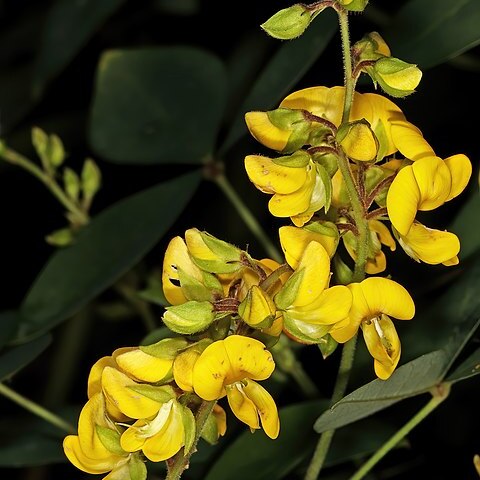Corolla yellow, turning orange or reddish with age; standard 11–13 × 10–14 mm, circular to oblate, sparsely to densely pubescent outside; wings as long as the standard, broad, glabrous or sometimes with some hairs along the midline or to the apex, without any folds between the veins; keel shorter than the wings, the petals 7–9 mm long, without or sometimes with a prominent crest, ciliolate on the upper margin near base.
Leaves usually well spaced; leaflets elliptic-lanceolate to elliptic, acute to subacute and apiculate at apex, cuneate at base, usually very sparsely pilose above, more densely so beneath; terminal leaflets mostly 2–3 times as long as the petiole, 20–70 × 9–35 mm; petiole 9–40 mm long; stipules 3–7 × 0.2–1 mm, filiform or linear-lanceolate, free, subglabrous to pilose, persistent or somewhat caducous.
Perennial, sprawling, dwarf shrub, 0.2-2.0 m high (plants in dry habitats stunted, seldom exceeding 0.25 m high, those in moist habitats and bright light > 1.5 m high); well-branched, indumentum variable. Leaflets variable, small suborbicular in dry habitats, large elliptical or obovate in moist habitats; ciliate. Inflorescences of terminal racemes. Flowering time Nov.-May.
Inflorescence leaf-opposed, pedunculate, racemose, sometimes long and lax, sometimes contracted and subumbelliform, usually 8–32-flowered; peduncle 2–10 cm long; bracts 2–4 mm long, linear-oblanceolate.
Stems up to 7 mm in diameter at the base; branches thinly to densely appressed or spreading fulvous to greyish pubescent, sometimes the hairs grouped, glabrescent.
Well-branched, sprawling shrub, 0.2-1.5 m. Leaves 3-foliolate, leaflets ovate, elliptic or obovate, ciliate, venation somewhat prominent. Flowers yellow.
Calyx 9–12 mm long, sometimes reddish, sparsely pubescent or pilose; the upper lip 2-lobed to below the middle with the lobes oblong-lanceolate.
Pod 35–60 × 5–6 mm, oblong, slightly curved, narrowed to the extremity, fulvous appressed pubescent or strigose.
Seeds 12–18 per pod, 3–3.5 mm long, dark brown, smooth.
Erect or scrambling subshrub 70–200 cm tall.

